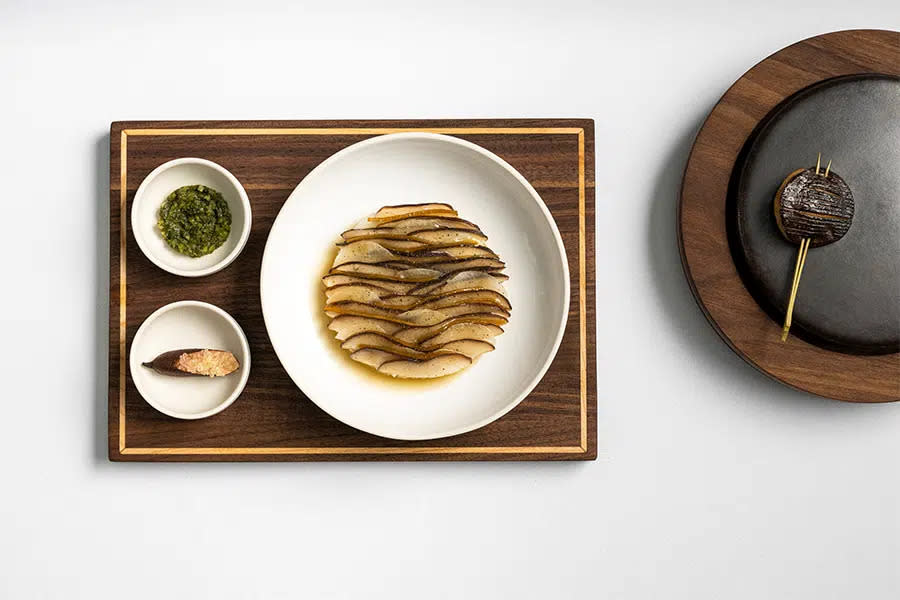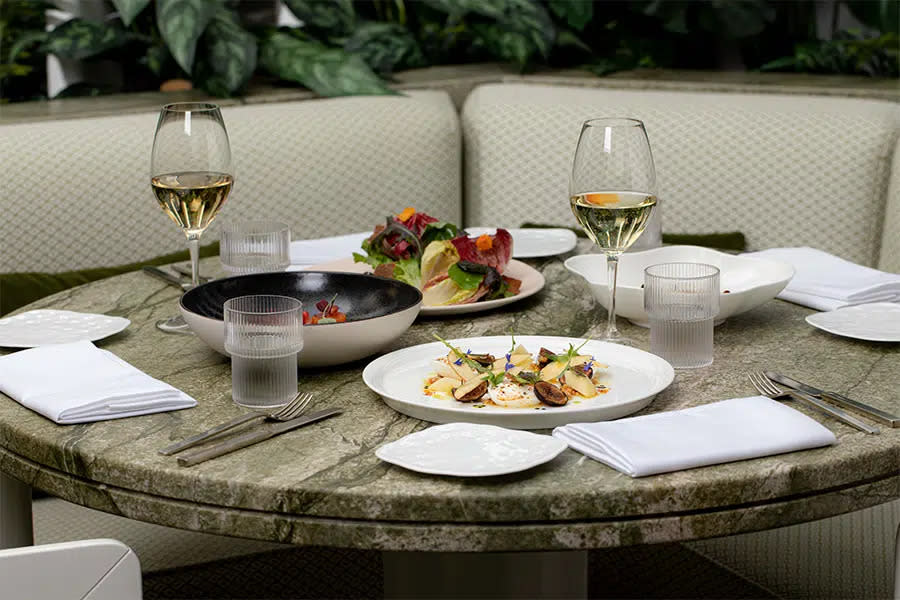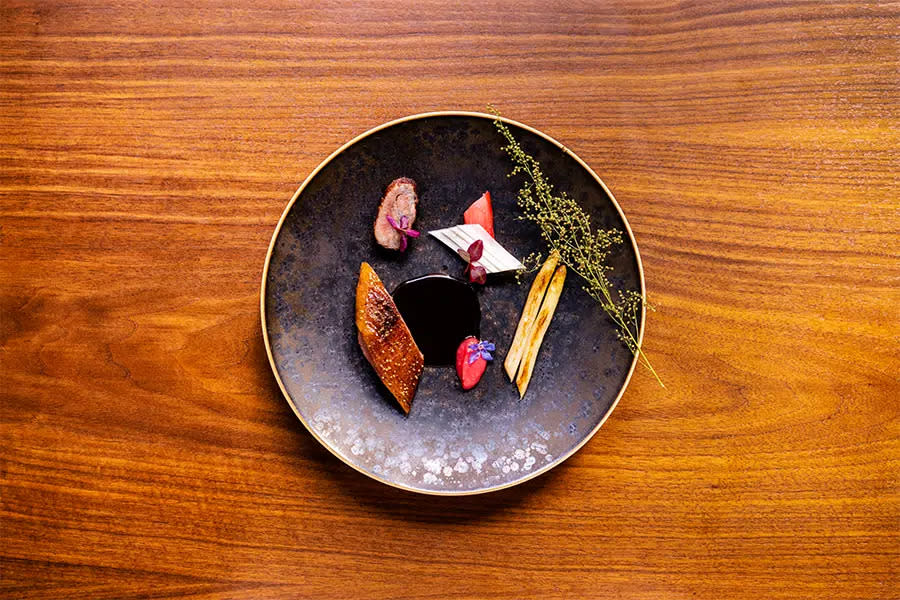Discover the most sustainable restaurants with elevated dining experiences in New York City.
Today, it’s not enough for a top restaurant to have fabulous food in a gorgeous setting. Diners want to know that chefs are paying attention to the climate crisis and animal welfare in their restaurants. To that end, many menus have changed in the past decade. We see more plant-based and seafood dishes on the menus, and chefs highlight their efforts to feature sustainably sourced seafood and humanely raised meats exclusively. It’s no longer a pleasant novelty to see out-of-season produce on menus; instead, guests want frequently changing menus that showcase the bounty of each micro-season, knowing that in-season produce is better for the environment and often tastes better, too.
But it’s not enough to just have sustainable bona fides. Guests are looking for chic settings, fantastic service, inventive cocktail menus, and thoughtfully curated wine lists. Our roundup of the best luxury sustainable restaurants in New York City is split into several categories, but naturally, many could fit into several categories. Whether you’re searching for a quintessential fine-dining experience or a casual pizza with ethically sourced wine, you’ll find it here.
Plant-based

Chefs are increasingly looking to plant-based dishes and menus in order to become more sustainable. Of course, gourmands aren’t satisfied with simple dishes, so these chefs must be inventive when crafting their menus, transforming humble ingredients into culinary masterpieces. Some chefs have been preaching this ethos for years, including Amanda Cohen, who founded the iconic vegetarian and vegan restaurant Dirt Candy. But more high-profile chefs have joined the challenge, like Daniel Humm of three-Michelin-starred restaurant Eleven Madison Park, who caused a global sensation when he transformed the world’s best restaurant into a plant-based, fine-dining oasis.
Veggie Forward

Some restaurants aren’t fully plant-based but instead offer many vegetarian and vegan dishes without drawing attention to the small amount of meat on the menu. Sure, there might be a steak to keep omnivores happy, but they probably won’t notice that nearly every other dish is seafood-focused or plant-based. This approach appeals to diners who wouldn’t go to a solely plant-based restaurant, and these small steps can ultimately create significant changes in the industry and diners’ habits.
Sushi
Sushi chefs are keenly attuned to difficult and changing circumstances marine life faces in the oceans today. Top sushi restaurants exclusively offer omakase tasting menus that feature the freshest catches of the day. Their guests understand that each dining experience can be different based on market availability. In addition, only offering a set menu allows chefs to minimize food waste because they know exactly how much they need.
Three Michelin Stars

There are five restaurants in New York City that have three Michelin stars, and each is at the top of its craft. Masa and Eleven Madison Park are featured in the sushi and plant-based sections due to their tightly focused menus. Per Se, Le Bernardin, and Chef’s Table at Brooklyn Fare offer a different dining experience through similar fine-dining lenses. Today, many restaurants primarily feature seafood as a more sustainable option than red meat. Le Bernardin has always focused on exquisitely prepared seafood since it opened 30 years ago. Similarly, Chef’s Table at Brooklyn Fare highlights shellfish and seafood. Per Se blends French and American cuisine in chef Thomas Keller’s unique style. Le Bernardin and Per Se also offer vegetarian tasting menus, which many three-Michelin-starred establishments do not.
Fine Dining
When you want a magnificent fine-dining experience that is a little more accessible, look to two-Michelin-starred restaurants. They have the same fantastic cuisine but can be more flexible. Gabriel Kreuther has two options: a more formal dining room with a tasting menu, and à la carte at the bar and lounge. Daniel’s prix-fixe menu offers more choices for picky eaters, and Jean-Georges has three tasting menus. Each restaurant cooks at the highest level using the finest ingredients, emphasizing seasonality and sustainability.
Tasting Menus
By their very nature, tasting menus allow chefs to reduce food waste and their carbon footprint. These menus frequently change seasonally, if not daily, allowing chefs to work with the ingredients that are at their peak at that very moment. You won’t find out-of-season ingredients that were flown in from a far-flung locale. Chefs develop deep relationships with their purveyors so they know precisely when to highlight each component in their changing menus.

Interesting Wine Lists
When it comes to sustainability, many people overlook wine. However, a restaurant’s wine list can tell you a lot about its commitment to sustainability and working with producers that care for the earth and their environmental impact. Talented wine directors and sommeliers can craft unique wine lists featuring smaller producers and unusual grape varieties, or focus on natural, organic, biodynamic, or sustainable viticultural practices. Wine is such an important part of the experience at Claud that it even created a monthly wine club to share its finds with you at home.
The Four Horsemen has a 53-page wine list focusing on unique producers and natural wine. At Corner Bar inside the buzzy Nine Orchard hotel, wine director Watson Brown, an Eleven Madison Park alum, seeks out esoteric offerings to complement chef Ignacio Mattos’s cuisine. An interesting wine list is at the heart of Pasquale Jones, where the team pairs excellent pizzas with unique wines.
Farm to Table

Farm-to-table restaurants have always been at the forefront of sustainable dining. By featuring produce and meat from their own farms or partner farms, these chefs can tightly control animal welfare, organic farming practices, and more. These menus frequently name the farms where they source each ingredient. One White Street’s chef, Austin Johnson, built a farm in order to provide his restaurant with the best produce year-round. Blue Hill, a pioneer in the farm-to-table movement in New York, operates two restaurants, one at the farm and one in the city. In Brooklyn, Olmsted features some ingredients grown in its backyard garden.
Focused on Producers
Others highlight their selective network of producers and farms. Verōnika features the names of many farms on its menus, or notes the ways in which the animals were raised. Musket Room’s mission is to work within a sustainable ecosystem featuring producers that match its values, and it showcases many of its partners on its website. Perry St is known for its sourcing from the iconic Union Square farmer’s market, just a few blocks away, where many New Yorkers are picking up produce for their meals, too. Chef TJ Steele at Claro personally sources his handpicked, non-GMO heirloom corn from farms in Oaxaca, Mexico.
French

French cuisine remains the ultimate for many when it comes to fine dining. Indeed, many of the top Michelin-starred restaurants in the US offer classical French menus. However, a new crop of chefs is reinterpreting French cooking for the next generation of diners. These unique menus feature twists on traditional dishes or dining experiences while retaining the heart and soul of French cuisine. All prize their relationships with top producers, and many have more sustainable menu options, including plant-based dishes.
Korean
Many of the city’s hottest reservations are at Korean restaurants. Inventive cocktails, sophisticated cuisine, and fantastic service in a chic environment combine to create a unique dining experience that stands out in today’s crowded dining scene. The chefs play with traditional dishes from their upbringing as well as contemporary cuisine. Regardless of the direction of the cuisine, you can be assured that the producers are top-notch.
American

These refined American restaurants show the breadth and depth of the country’s cuisine today. Unique and unusual dishes sit alongside classic comfort fare, all prepared with care and an eye on sustainable sourcing and restaurant practices.
Italian
Italian cuisine can be deceptively simple. Many dishes have few ingredients, which means that every element, from the olive oil to the homemade pasta and fresh tomatoes, must be perfect. Chefs prize their producers, many of whom use time-honored techniques and artisanship that honor their heritage and are frequently better for the environment than mass-produced goods. In New York, you’re spoiled for choice with Italian restaurants, but these stand above the rest.
